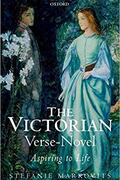
The Victorian Verse-Novel: Aspiring to Life considers the rise of a hybrid generic form, the verse-novel, in the second half of the nineteenth century. Such poems combined epic length with novelistic plots in the attempt to capture not a heroic past but the quotidian present. Victorian verse-novels also tended to be rough-mixed, their narrative sections interspersed with shorter, lyrical verses in varied measures. In flouting the rules of contemporary genre theory, which saw poetry as the purview of the eternal and ideal and relegated the everyday to the domain of novelistic prose, verse-novels proved well suited to upsetting other hierarchies, as well, including those of gender and class.
The genre’s radical energies often emerge from the competition between lyric and narrative drives, between the desire for transcendence and the quest to find meaning in what happens next; the unusual marriage plots that structure such poems prove crucibles of these rival forces. Generic tensions also yield complex attitudes towards time and space: the book’s first half considers the temporality of love, while its second looks at generic geography through the engagement of novels in verse with Europe and the form’s transatlantic travels. Both well-known verse-novels (Elizabeth Barrett Browning’s Aurora Leigh, Arthur Hugh Clough’s Amours de Voyage, Coventry Patmore’s The Angel in the House) and lesser-known examples are read closely alongside a few nearly related works (Tennyson’s Idylls of the King, Robert Browning’s The Ring and the Book). An Afterword traces the verse-novel’s substantial influence on the modernist novel.